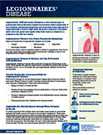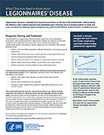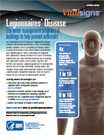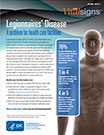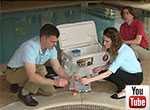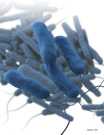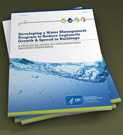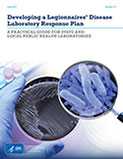Materials
The following materials provide information on Legionnaires’ disease, including tools for investigating outbreaks and developing water management programs.
Fact Sheets
Legionnaires’ Disease [1 page]
This fact sheet describes what Legionnaires’ disease is, its symptoms, how it’s spread and treated, and who is at increased risk.
This fact sheet is also available in Spanish [1 page].
What Clinicians Need to Know about Legionnaires’ Disease [2 pages]
This 2-page fact sheet describes diagnosis, testing, treatment, reporting, etiology, transmission, risk factors, common sources of infection, and prevention of Legionnaires’ disease.
Vital Signs: Legionnaires’ Disease [6.24 MB, 4 pages]
This 4-page fact sheet describes the most common settings for Legionnaires’ disease outbreaks that CDC investigated between 2000 through 2014, explains the reasons for those outbreaks occurring, and provides tips for what can be done to help prevent Legionnaires’ disease. Also see Vital Signs.
This fact sheet is also available in Spanish [3.68 MB, 4 pages].
Vital Signs: Legionnaires’ Disease [3.55 MB, 4 pages]
This 4-page fact sheet describes the problem of Legionnaires’ disease in healthcare facilities and how effective water management programs can prevent it, with an emphasis on establishing a team approach. Also see Vital Signs.
This fact sheet is also available in Spanish [2.75 MB, 4 pages].
Videos
Environmental Investigation Videos
Designed for public and environmental health professionals, CDC developed six instructional videos to explain various environmental aspects of legionellosis outbreak investigations.
Graphics
Illustration of Legionella pneumophila, the bacterium that causes the majority of Legionnaires’ disease cases and outbreaks.
Download this graphic (22.8 MB,300 dpi resolution)
Cooling towers, which are often part of the air conditioning systems of large buildings, are a common source of Legionella exposure in outbreaks. Cooling towers need to be properly maintained in order to prevent Legionnaires’ disease.
Download this graphic (5.37 MB, 96 dpi resolution)
Photos
Water samples from a building experiencing a Legionnaires’ disease outbreak are unpacked at CDC’s Legionella Laboratory.
Download this graphic (24.3 MB, 300 dpi resolution)
A CDC microbiologist pours water samples from a building experiencing a Legionnaires’ disease outbreak into a filtration system to test for Legionella.
Download this graphic (30 MB, 300 dpi resolution)
Legionella pneumophila, a bacterium that can cause Legionnaires’ disease, growing on specialized microbiological media (BCYE).
Download this graphic (17.3 MB, 300 dpi resolution)
Podcasts
CDC Vital Signs–Legionnaires’ Disease (1:14 minutes, Date Released: 6/7/2016)
This podcast is based on the June 2016 CDC Vital Signs report. People can get Legionnaires’ disease, a serious type of lung infection, from breathing in small water droplets of water contaminated with Legionella germs. Learn what can be done to help prevent Legionnaires’ disease outbreaks and keep people safe.
This podcast is also available in Spanish.
Public Service Announcement
Legionnaires’ Disease PSA (1:00 minute, Date Released: 6/7/2016)
This 60-second public service announcement is based on the June 2016 CDC Vital Signs report. People can get Legionnaires’ disease, a serious type of lung infection, from breathing in small water droplets of water contaminated with Legionella germs. Learn what can be done to help prevent Legionnaires’ disease outbreaks and keep people safe.
Toolkits
Developing a Water Management Program to Reduce Legionella Growth & Spread
This 36-page toolkit is a practical guide to implementing industry standards for buildings with large or complex water systems. This toolkit will help you develop and implement a water management program to reduce your building’s risk for growing and spreading Legionella. If you already have a program, this toolkit will help you assess and strengthen it. Included are practical resources to help you ensure that your water management program is comprehensive, effective, and in line with industry standards. This toolkit also highlights special considerations for healthcare facilities.
Developing a Legionnaires’ Disease Laboratory Response Plan
This 29-page practical guide for state and local public health laboratories provides a road map for laboratory staff and leadership to create a Legionnaires’ disease laboratory response plan (LDLRP). This LDLRP toolkit includes resources for identifying a response team, creating in-house investigation workflows, and establishing relationships with referral laboratories. Use the toolkit’s sample worksheets to prepare a plan for how your laboratory will respond to a Legionnaires’ disease cluster or outbreak.
- Page last reviewed: June 7, 2016
- Page last updated: July 12, 2017
- Content source:


 ShareCompartir
ShareCompartir
